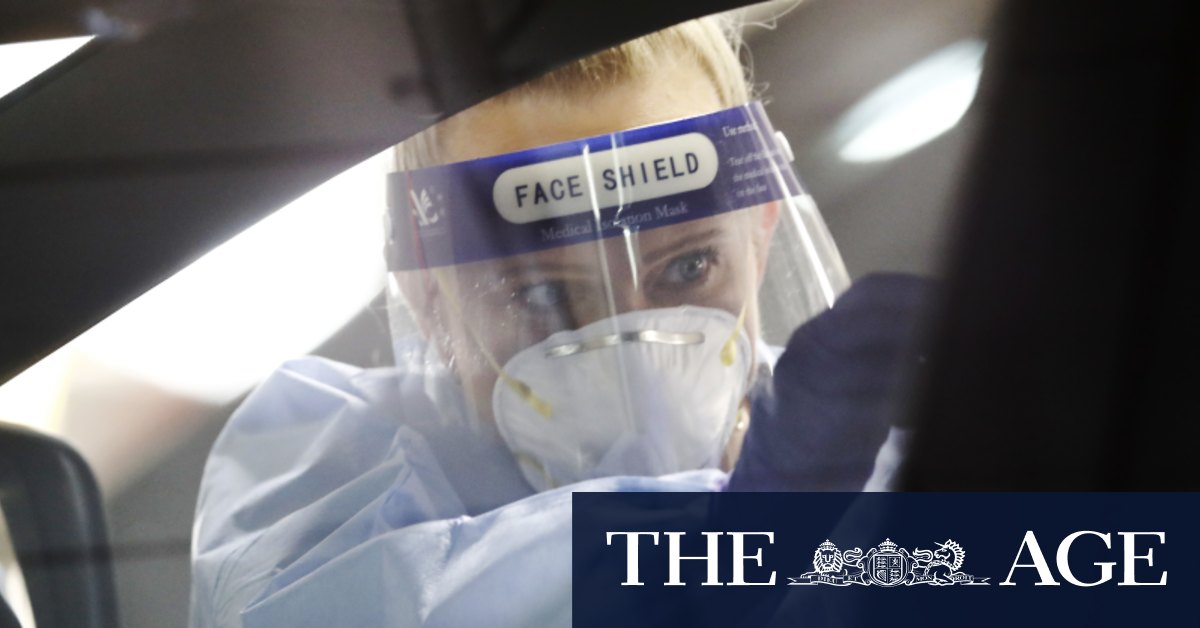
The number of new coronavirus cases in Victoria has risen and the rolling 14-day average has increased after 15 new cases were recorded on Monday.
It means the targets for easing lockdown restrictions in line with step three of the state's road map to recovery next week are now unachievable.
Monday was another fatality-free day for Victoria, with the state's death toll remaining at 810.
The latest cases come after 11, 14 and 12 cases were recorded over the past three days.
They bring the statewide 14-day average, which has been tied to the next stage of easing lockdown restrictions, to 10.3 new cases per day – up from 9.6 on Sunday.
Victoria's 14-day average for new cases had to be below five, for Melbourne to move to step three of the state government's road map for easing restrictions on October 19. The government was also aiming for there to have been five or fewer mystery cases between October 4 and October 18.
But those benchmarks cannot be reached in the next seven days.
Melbourne has overshot both of its original step three reopening targets, analysis of health department data shows.
Monday's increase of 15 new cases statewide means that it is now mathematically impossible for the five-day average to be below five on October 19.
For the 14-day average to be below five, no more than 70 cases in total could be recorded in the 14 days between October 5 and October 18. Melbourne is now seven days into that reference period, and 80 cases in total have been confirmed statewide, exceeding the limit by 10.
Monday also marked the first time in about two months that the state's 14-day rolling case average increased. That means more new cases confirmed on Monday (15), than there were two weeks ago (5).
Premier Daniel Andrews has indicated that thousands of Melbourne businesses hoping to reopen next week will have to wait longer. The Premier has suggested that the next restrictions to be eased will focus on increased social interaction, rather than economic measures.
Retail, hairdressers, beauty therapists and outdoor dining were flagged to reopen with strict hygiene protocols from October 19.
On Sunday, the Premier gave his strongest hint yet about which restrictions could be eased from next Monday, saying the five-kilometre travel limit was among measures the government would consider lifting for metropolitan Melbourne.
Mr Andrews suggested that economic measures would not be among those lifted in Melbourne, while in regional Victoria, where case numbers were lower, restrictions on businesses could be further eased.
"I think it will be safe for us to take some social steps ... in metropolitan Melbourne," he said.
Lockdowns should not be first resort, says WHO adviser
However, a special adviser to the Director-General of the World Health Organisation has said governments should not rely on strict lockdowns to control the spread of COVID-19.
Dr David Nabarro said lockdowns should be used to give governments and health systems time to organise and prepare for a pandemic, but should not be the default mechanism to slow the virus.
"The only time we believe a lockdown is justified is to buy you time to reorganise, regroup, rebalance your resources, protect your health workers who are exhausted – but by and large, we'd rather not do it," he said in an interview with conservative British magazine The Spectator.
"And so we really do appeal to all world leaders: stop using lockdown as your primary control method. Develop better systems for doing it. Work together and learn from each other."
Dr Nabarro said lockdowns had a particularly stark effect on poorer countries where many people lived below or at the poverty line. "[Lockdowns] just have one consequence that you must never, ever belittle — and that is making poor people an awful lot poorer," he said.
"It seems that we may well have a doubling of world poverty by next year ... We may well have at least a doubling of child malnutrition. This is a terrible, ghastly global catastrophe."
Virus can last up to a month on some surfaces
Meanwhile, the virus that causes COVID-19 can last up to 28 days on surfaces like mobile phone and ATM screens, much longer than previously thought, but lasts for much less time on softer surfaces, new CSIRO research shows.
Previous research from US health authorities showed the virus could be detected in aerosols for up to three hours and on plastic and stainless steel surfaces for up to three days.
Australian researchers tested the virus on polymer banknotes, de-monetised paper banknotes and common surfaces including brushed stainless steel, glass, vinyl and cotton cloth.
On glass, stainless steel and paper banknotes, the virus lasted for up to 28 days at 20 degrees.
Box Hill Hospital cluster grows
Victoria recorded 12 new cases on Sunday, including two linked to the Box Hill Hospital cluster and one to the Chadstone outbreak, and one death. The state recorded 14 cases on Saturday and no deaths.
As of Sunday, there were 12 cases linked to the Box Hill Hospital, including three staff members, two patients and seven household contacts.
At least 33 people have been infected as a result of the Butcher Club-Chadstone cluster.
New face-mask rules came into effect on Monday. All Victorians are now required to wear a fitted face mask that covers their nose and mouth when they leave home, no matter where they live. Scarves, bandannas, loose neck warmers or loose snoods and plastic face shields are no longer permitted.
with Sumeyya Ilanbey
Paul is a reporter for The Age.
Craig Butt joined The Age in 2011 and specialises in data-driven journalism.
https://news.google.com/__i/rss/rd/articles/CBMiiAFodHRwczovL3d3dy50aGVhZ2UuY29tLmF1L25hdGlvbmFsL3ZpY3RvcmlhL3ZpY3RvcmlhLXMtMTQtZGF5LWNhc2UtYXZlcmFnZS1yaXNlcy1hcy0xNS1uZXctY29yb25hdmlydXMtY2FzZXMtZW1lcmdlLTIwMjAxMDEyLXA1NjQ0cS5odG1s0gGIAWh0dHBzOi8vYW1wLnRoZWFnZS5jb20uYXUvbmF0aW9uYWwvdmljdG9yaWEvdmljdG9yaWEtcy0xNC1kYXktY2FzZS1hdmVyYWdlLXJpc2VzLWFzLTE1LW5ldy1jb3JvbmF2aXJ1cy1jYXNlcy1lbWVyZ2UtMjAyMDEwMTItcDU2NDRxLmh0bWw?oc=5
2020-10-11 21:39:00Z
CAIiELYq8NO3VbExJ-FfgYGXTfQqGQgEKhAIACoHCAowgNjvCjCC3s8BMKCtmwY
Bagikan Berita Ini














0 Response to "Victoria's 14-day case average rises as 15 new coronavirus cases emerge - The Age"
Post a Comment